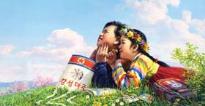Inside North Korea's Flower Cult
 The Economist reports:
The Economist reports:
SOMETIMES there are Kimilsungia exhibitions. Sometimes there are Kimjongilia ones. Citizens of Pyongyang are also treated to combined Kimilsungia and Kimjongilia shows. One such got underway at the beginning of this month, at the Kimilsungia-Kimjongilia Exhibition House: innumerable pots filled with the same two kinds of plant, a monotony alleviated only by a guide’s prediction that North Korea will one day get a third variety.
Kim Jong Il has resisted his late father Kim Il Sung’s predilection for studding North Korea with statues of himself (Pyongyang’s first of Kim Jong Il was reportedly unveiled earlier this year, 16 years after he succeeded his father as North Korea’s leader). Instead, Kim Jong Il says it with flowers. Foreign correspondents invited in for celebrations of the ruling party’s 65th birthday on October 10th saw them everywhere: on billboards, on huge digital screens erected for the festivities on Kim Il Sung Square, in a cascading display in the hotel lobby and in endless profusion at the exhibition (along with huge portraits of the two Kims).
Kim Il Sung officially remains president, against the odds, but the Kimjongilia, a giant red begonia, somehow leaves its visual stamp on Pyongyang even more pervasively than the Kimilsungia, a normal-sized purple orchid. It might be said that the Kimjongilia’s bouffant petals echo the hairstyle of North Korea’s eponymous ruler, but a guide at the exhibition has a more politically correct explanation of the flower’s appearance. Its bright red hue, she says, reflects Kim Jong Il as a “person of passion, with a very strong character”.
A journalist asked whether different temperature requirements made it difficult to keep begonias and orchids together. “We grow them with our hearts”, said the guide. In August North Korea’s Kimilsungia and Kimjongilia Research Centre came up with what might be a more reliable way of getting the best out of the Kimjongilia. After “years of research”, said the state news agency KCNA, it devised a chemical agent that could lengthen the blooming period by a week in summer or by 20 days in winter.
Interspersed among the potted plants were occasional models of items representing the two leaders’ great achievements: “a nuclear weapon” was how the guide described one missile-like object. Another was a model of a rocket supposedly carrying a satellite into space (the actual rocket blew up after launch in April 2009, but North Korean officials resolutely insist that it successfully put a satellite into orbit). Another represented a hand grenade, rifle and rocket launcher. But, no doubt deliberately, it was the Kimjongilia’s redness that struck the eye.
One display was of potted Kimjongilias supposedly donated by foreign diplomatic missions. China’s was uppermost, together with a photograph of Kim Jong Il shaking hands with China’s president, Hu Jintao. Individual European countries were conspicuous by their absence, but there was one pot plant there in the name of the European Union. (The North Koreans had tried to gouge each of the seven European embassies in Pyongyang for flower contributions—though hard currency, it was understood, would do nicely in lieu. The single Kimjongilia was their cost-saving solution.)
Oddly for plants that have acquired such crucial political significance in North Korea—the army has its own huge breeding centre for them—both are actually foreign creations. The Kimilsungia was presented in 1965 by Indonesia’s founding president, Sukarno, and the Kimjongilia arrived in 1988, courtesy a Japanese botanist. Kim Jong Un, Kim Jong Il’s anointed successor, who was seen by foreign journalists for the first time on October 9th and 10th, has yet to acquire a flower. “In future we will have one”, assures the guide.
Click here to read more.

